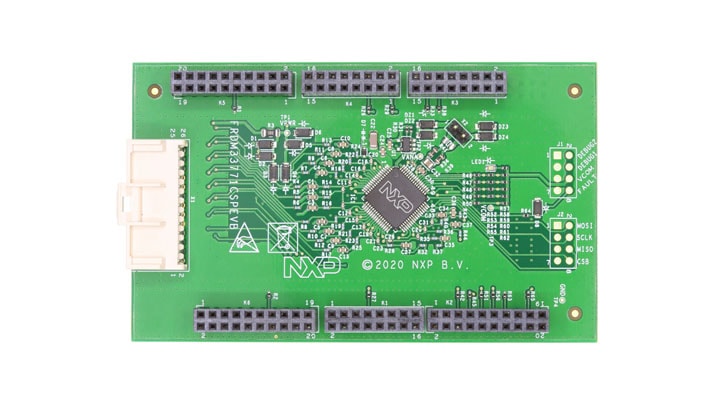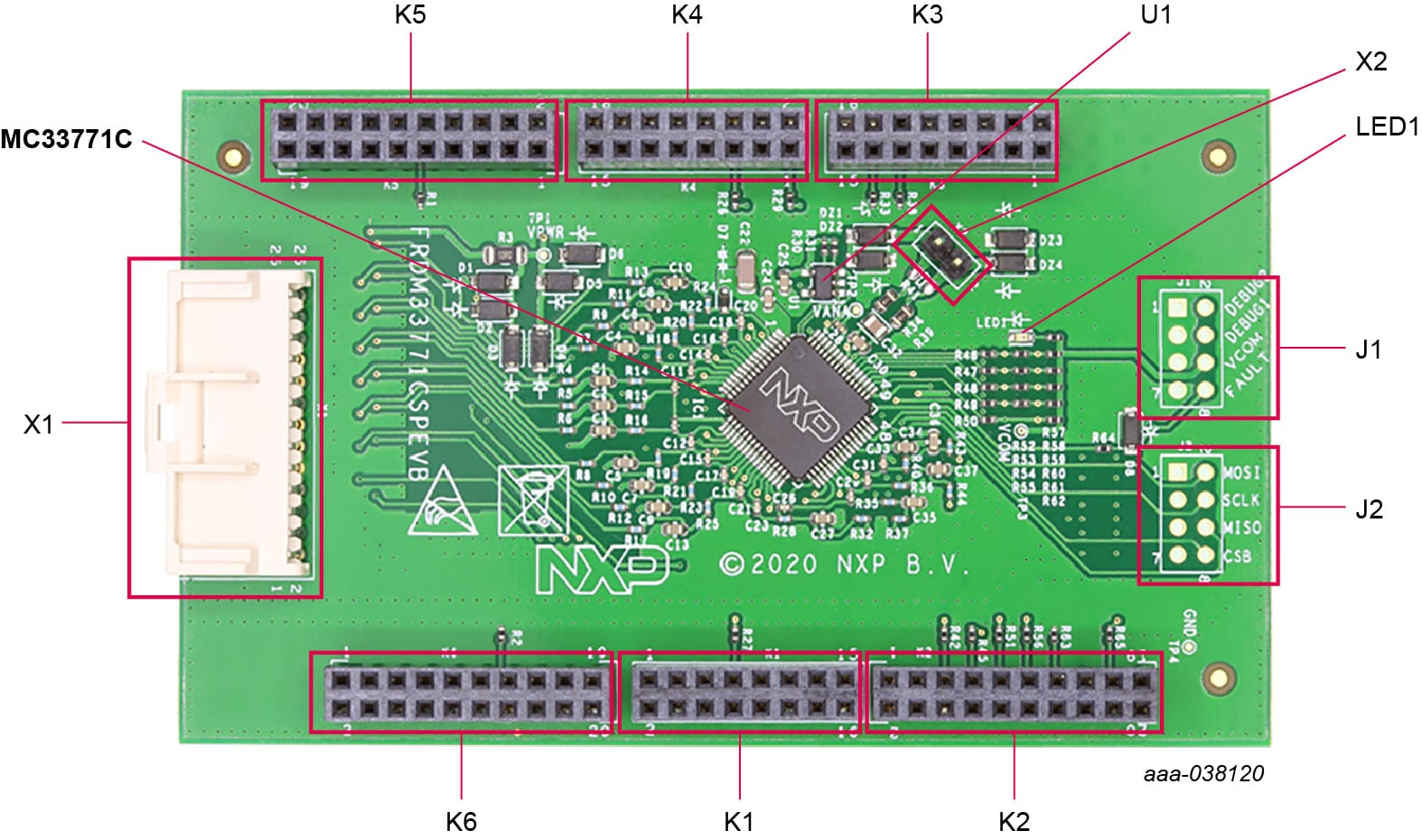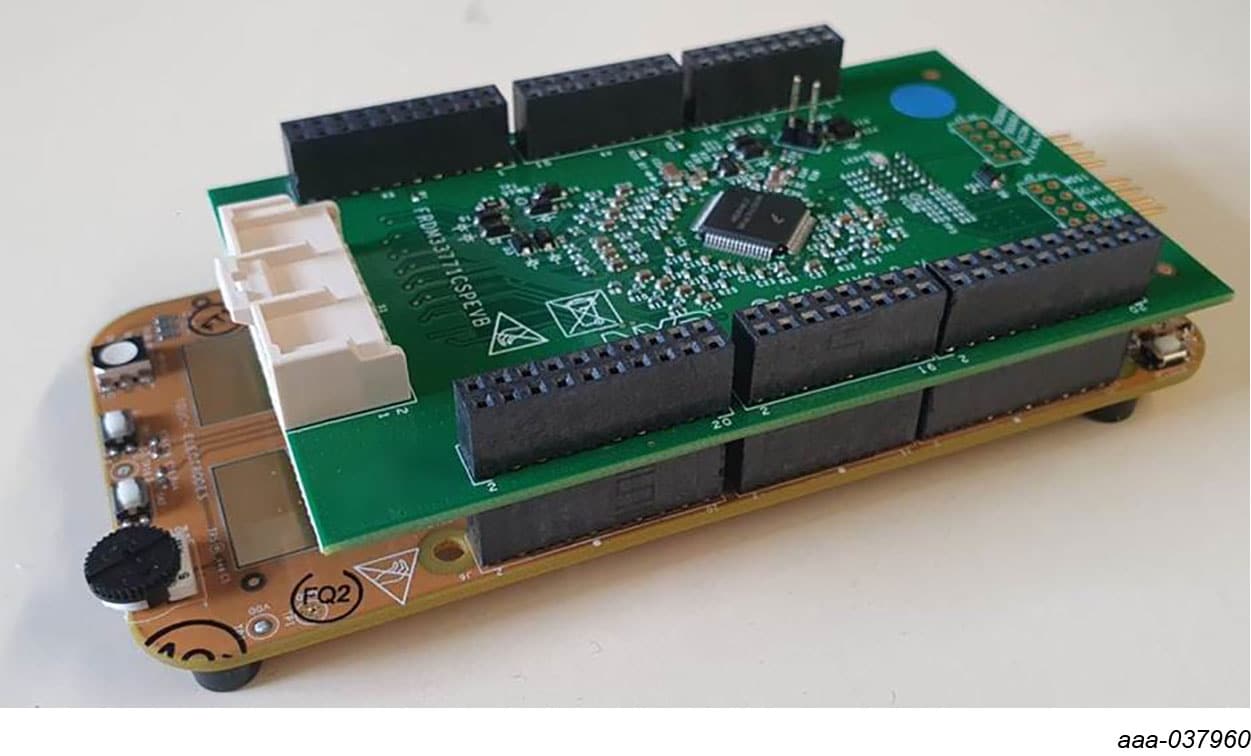Get Started with the FRDM33771CSPEVB
Contents of this document
-
Get Started
-
Get Hardware
-
Configure Hardware
Sign in to save your progress. Don't have an account? Create one.

Purchase your FRDM33771CSPEVB | SPI evaluation board
1. Get Started
The NXP® analog product development boards provide an easy-to-use platform for evaluating NXP products. The boards support a range of analog, mixed-signal and power solutions. They incorporate monolithic integrated circuits and system-in-package devices that use proven high-volume technology. NXP products offer longer battery life, a smaller form factor, reduced component counts, lower cost and improved performance in powering state-of-the-art systems.
This page will guide you through the process of setting up and using the FRDM33771CSPEVB evaluation board.
1.1 Kit Contents/Packing List
The 'FRDM33771CSPEVB' contents include:
- Assembled and tested FRDM33771CSPEVB in an anti-static bag
- 20 cm 26-pin cell terminal cable
- Quick start guide
1.2 Additional Hardware
In addition to the kit contents, the following hardware is necessary or beneficial when working with this kit.
- A 7 to 14-cell battery pack or a battery pack emulator, such as BATT-14CEMULATOR
1.3 User Manual
Refer to UM11402, FRDM33771CSPEVB evaluation board for additional details on the featured components and board configuration.
2. Get to Know the Hardware
2.1 Board Description
The FRDM33771CSPEVB serves as a hardware evaluation tool in support of NXP's MC33771C device. The MC33771C is a battery cell controller that monitors up to 14 lithium-ion battery cells. It is designed for use in both automotive and industrial applications.
The device performs ADC conversion on the differential cell voltages and currents. It is also capable of battery charge coulomb counting and battery temperature measurements. The FRDM33771CSPEVB is an ideal platform for rapid prototyping of MC33771C-based applications that involve current, voltage and temperature sensing.
The FRDM33771CSPEVB supports standard SPI interface. The information is digitally transmitted to a microcontroller for processing.
2.2 Board Features
- Standard SPI communication
- LED indicator for operation mode
- Cell-balancing resistors
- Cell sense input with RC filter
- GPIO: digital I/O, wake-up inputs, convert trigger inputs, ratiometric analog inputs, analog inputs with absolute measurements
- EEPROM (connected to the IC with I²C interface) to store user-defined calibration parameters
- Fault detection pin report
- Current measurement input via external shunt
2.3 Board Components
Overview of the 'FRDM33771CSPEVB evaluation board'

| Label | Name | Description |
|---|---|---|
| U1 | 24LC01BT-I/OT | IC memory EEPROM |
| IC1 | MC33771C | Battery-cell controller IC |
| LED1 | VCOM LED | Indicates whether or not the device is in Normal or Low-power mode |
| K1 to K6 | — | SPI connectors to S32K144EVB |
| X1 | — | Supply cells connector |
| X2 | — | Isense inputs connector |
| J1, J2 | — | Optional debug connectors |
2.4 Additional Board Support
Refer to UM11402, FRDM33771CSPEVB evaluation board user manual for additional details on the featured components.
3. Configure the Hardware
The FRDM33771CSPEVB can be configured as a shield board connected to an S32K144EVB board.
When FRDM33771CSPEVB and the S32K144EVB are connected together, the SPI connector is directly connected with the MCU SPI pins.
In this configuration, power is supplied to the S32K144EVB through a USB cable connected between the S32K144EVB board and a PC. No external power supply is required.

3.1 Battery Emulator Connection
The FRDM33771CSPEVB supports the use of a battery cell emulator such as NXP's BATT-14CEMULATOR board.
The BATT-14CEMULATOR is a 14-cell battery emulator board that provides an intuitive way to change the voltage across any of the 14 cells and four voltage outputs in order to emulate four external NTC. A minimum of 7 cells and a maximum of 14 cells can be monitored.
The emulator board can be connected to the FRDM33771CSPEVB connector X1 using the provided supply cable.

To exercise the FRDM33771CSPEVB in combination with the BAT-14CEMULATOR, a graphical user interface is available at MC33771C/MC33772C (Battery Cell Controller) Evaluation GUI.
3.2 Additional Board Support
Refer to UM11402, FRDM33771CSPEVB evaluation board user manual for additional details on the hardware configuration.
3.3 Ready to Use
Start embedded application development.
Design Resources
Learn
Product Summary Page
The product summary page for MC33771C is at 14-Channel Li-Ion Battery Cell Controller IC.
Tool Summary Page
The tool summary page for FRDM33771CSPEVB board is at Evaluation Board for MC33771C with SPI Communication.
The page provides overview information, technical and functional specifications, ordering information, documentation and software. The 'Getting Started' module provides quick-reference information applicable to using the FRDM33771CSPEVB board, including the downloadable assets.
References
In addition to our 'MC33771C: 14-Channel Li-ion Battery Cell Controller IC' page, you may also want to visit:
Tool pages:
- S32K144EVB-Q100: S32K144 Evaluation Board
- BATT-14CEMULATOR: 14-Cell Battery Pack Emulator to Supply MC33771C BCC EVBs
Application pages:
Hardware pages:
Software pages: